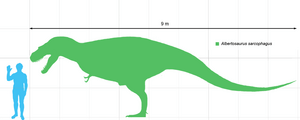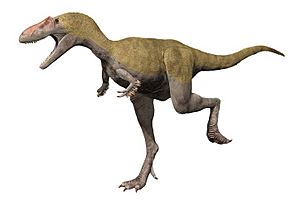Albertosaurus facts for kids
Quick facts for kids AlbertosaurusTemporal range: Upper Cretaceous
|
|
|---|---|
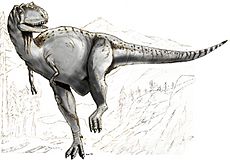 |
|
| Sketch of Albertosaurus | |
| Scientific classification | |
| Kingdom: | |
| Phylum: | |
| Class: | |
| Superorder: | |
| Order: | |
| Suborder: | |
| Family: | |
| Genus: |
Albertosaurus
Osborn, 1905
|
| Species | |
|
|
Albertosaurus (say "al-BER-toh-SAWR-us") means "Alberta lizard." This awesome dinosaur was a cousin of the famous Tyrannosaurus rex. But Albertosaurus was a bit smaller and lived millions of years before T. rex.
It walked on two strong legs and had a big head filled with sharp, saw-like teeth. Its arms were short, with two fingers on each hand. A long tail helped it balance and turn quickly. Its powerful back legs had three-toed feet with sharp claws.
Albertosaurus was built lighter than Tyrannosaurus. This probably made it a faster runner, especially in open areas.
Contents
What did Albertosaurus look like?
Albertosaurus was a large dinosaur, but smaller than some of its relatives like Tarbosaurus and Tyrannosaurus. Most adult Albertosaurus were about 9 meters (30 feet) long. That's about the length of a school bus! Some very old ones could even grow to be over 10 meters (33 feet) long.
Scientists think an adult Albertosaurus weighed between 1.3 and 1.7 tonnes (about 2,800 to 3,700 pounds). That's like two small cars! Like other big meat-eating dinosaurs (theropods), Albertosaurus walked on two legs. Its long tail helped it balance its heavy head and body. Its front arms were very small for its size and only had two fingers. Younger Albertosaurus were likely very fast runners.
Skull and Teeth
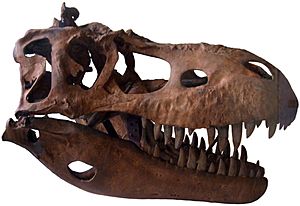
The huge skull of Albertosaurus was about 1 meter (3.3 feet) long in the biggest adults. It sat on a short, S-shaped neck. The skull had large holes, called fenestrae. These holes made the head lighter and provided space for muscles and sense organs.
Its long jaws held 58 or more banana-shaped teeth. Other large tyrannosaurids usually had fewer teeth. Gorgosaurus, for example, had at least 62 teeth. Unlike most meat-eating dinosaurs, Albertosaurus had different kinds of teeth in different parts of its mouth. The teeth at the very front of its upper jaw were smaller and D-shaped. The teeth in its cheeks were strong. They were shaped to resist the force of struggling prey.
The bite force of Albertosaurus was strong, but not as strong as Tyrannosaurus. Its back teeth could bite with a force of about 3,413 Newtons. Above its eyes, Albertosaurus had short bony crests. These might have been brightly colored. They could have been used to attract a mate during courtship.
How did Albertosaurus get its name?
Albertosaurus was named by Henry Fairfield Osborn in 1905. He named it after Alberta, a Canadian province. This is where the first bones were found. The name also includes the Greek word sauros, which means "lizard." This is a common ending for dinosaur names.
The full name is Albertosaurus sarcophagus. The word sarcophagus comes from Ancient Greek words meaning "flesh-eating." It's the same word used for a stone coffin.
How did Albertosaurus grow and live?
The youngest Albertosaurus fossil found was a two-year-old. It weighed about 50 kilograms (110 pounds) and was a little over 2 meters (6.6 feet) long. The oldest and largest Albertosaurus found was 28 years old. It was about 10 meters (33 feet) long.
As Albertosaurus grew, its teeth changed a lot. If scientists hadn't found young and adult skeletons together, they might have thought the young dinosaurs' teeth belonged to a different species!
Most Albertosaurus fossils found are of animals that were 14 years or older when they died. It's rare to find fossils of young dinosaurs. This is because their smaller bones were less likely to be preserved over time. Even though young Albertosaurus were quite large, their fossils are still rare compared to adults. More than 30 Albertosaurus specimens of all ages have been found.
Did Albertosaurus hunt in packs?
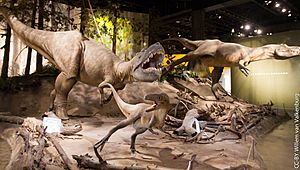
We know that plant-eating dinosaurs often lived in groups. But it's rare to find many dinosaur predators at the same place. However, many Albertosaurus fossils were found together in one spot. This suggests they might have lived and hunted in groups, like a pack.
Younger Albertosaurus had leg bones similar to very fast dinosaurs. This means they were probably quick runners. Scientists think that the younger, faster members of the pack might have chased prey towards the older, larger, and slower adults.
Young Albertosaurus might have also hunted different kinds of prey than adults. They could have filled a hunting role between the huge adults and much smaller meat-eating dinosaurs. This is similar to how modern Komodo dragons live. Young Komodo dragons start by eating insects. As they grow, they become the main predators on their islands.
Where did Albertosaurus live?
All known Albertosaurus fossils come from the Horseshoe Canyon Formation in Alberta, Canada. These rocks are from the Late Cretaceous Period, about 70 to 68 million years ago.
This area was once covered by a large inland sea. But as the climate cooled, the sea levels dropped. This exposed land that was once underwater. The Horseshoe Canyon Formation is famous for its many dinosaur fossils.
The area was home to many different animals. There were fish like sharks, rays, and sturgeons. Mammals included small creatures like multituberculates. Freshwater environments had turtles and crocodilians.
Dinosaurs were very common, especially duck-billed dinosaurs (hadrosaurs) like Edmontosaurus and Hypacrosaurus. Horned dinosaurs (ceratopsians) and ostrich-like dinosaurs (ornithomimids) were also common. All these plant-eating dinosaurs would have been prey for various meat-eaters. These included smaller theropods and, of course, Albertosaurus.
Adult Albertosaurus were the top predators in this ancient environment. Younger Albertosaurus might have hunted different prey, filling other roles in the food chain.
Images for kids
-
Holotype specimen CMN 5600
-
The Red Deer River near Drumheller, Alberta. Almost three-quarters of all Albertosaurus remains have been discovered alongside the river, in outcrops like the ones on either side of this picture.
-
Teeth from Dry Island and Drumheller, Royal Tyrrell Museum
-
Gorgosaurus, which was originally described as a second species of Albertosaurus, A. libratus
-
Cast in the Rocky Mountain Dinosaur Resource Center in Woodland Park, Colorado
See also
 In Spanish: Albertosaurus sarcophagus para niños
In Spanish: Albertosaurus sarcophagus para niños


